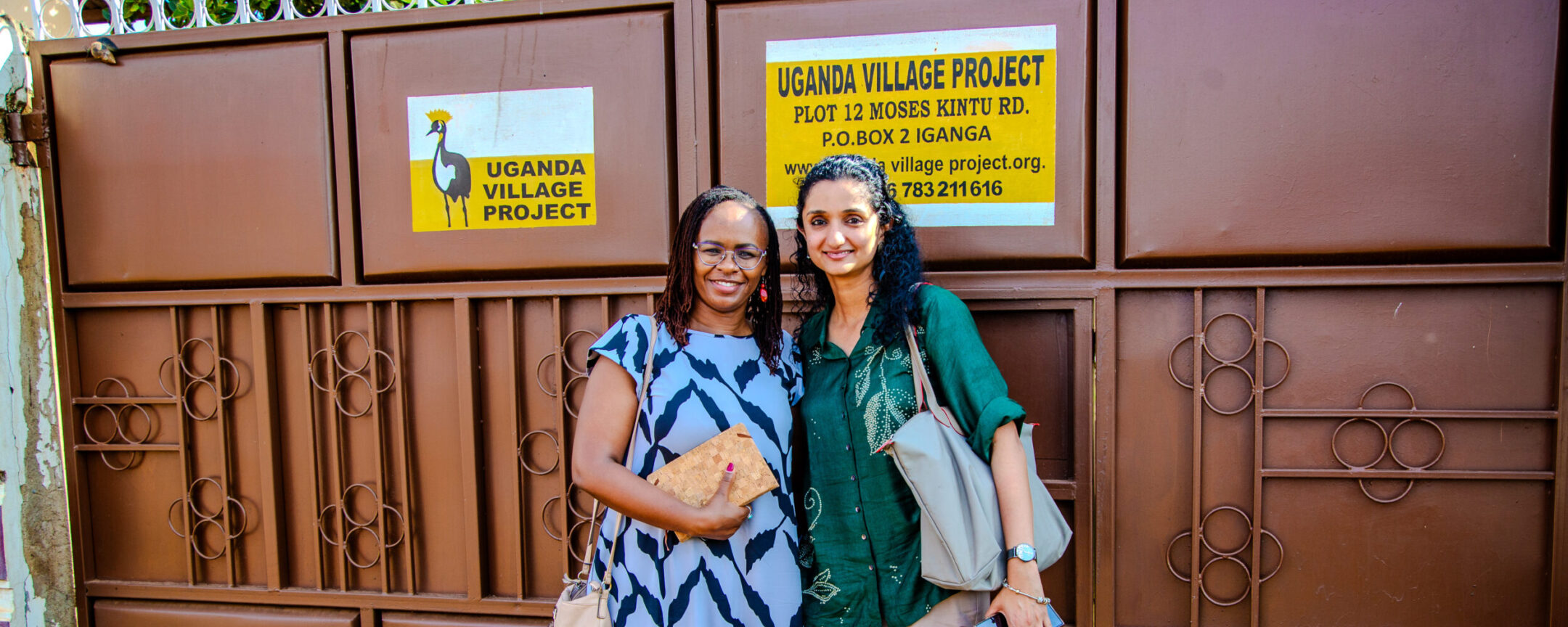By: Kee Rajagopal, Senior Program Officer and Dr. Esther Njoroge-Muriithi, Chief Program Officer
Recently, senior members of our program team, Kee Rajagopal and Dr. Esther Njoroge-Muriithi, conducted a site visit to our partners in Uganda. Once every three years, a member of our team or one of our medical advisors visits each partner facility for monitoring, evaluation and learning to help develop our partners’ surgical skills, assess clinical competency, and identify opportunities for continued growth. During their trip to Uganda, Kee and Esther kept a joint travel journal of their experiences at each facility and patient home they visited.
Below, you can read about the inspiring doctors and patients they met, the expansive countryside they encountered, and the powerful work that takes place each and every day in Uganda, supported by people like you.
Monday, April 28
A reflection by Dr. Esther Njoroge-Muriithi
Visiting Uganda Village Project
The day started very early—too early even for the birds. At 5 a.m. we were on the road. Destination: Iganga, home to our partner Uganda Village Project (UVP).
At 8:30 a.m. we were met by Alex, a program coordinator at UVP. He gave us a tour of the office and a bit of the organization’s history and work. Sprinkled around the office were framed certificates in appreciation for collaborative work benefiting the community.
Alex then led us to the town center where we met Janet at her tailoring shop. Janet is a vibe! She joyously welcomed us and generously shared her story with us. Her gratitude for being treated, and also receiving training in tailoring that has helped her sustain her family of four children could be felt in her words. She knelt in front of us, a common way of showing deep appreciation in Uganda. At the end of the visit she loaded us with goodies: avocados, mangoes and bananas all from her farm. It was such a joyful start to our day.
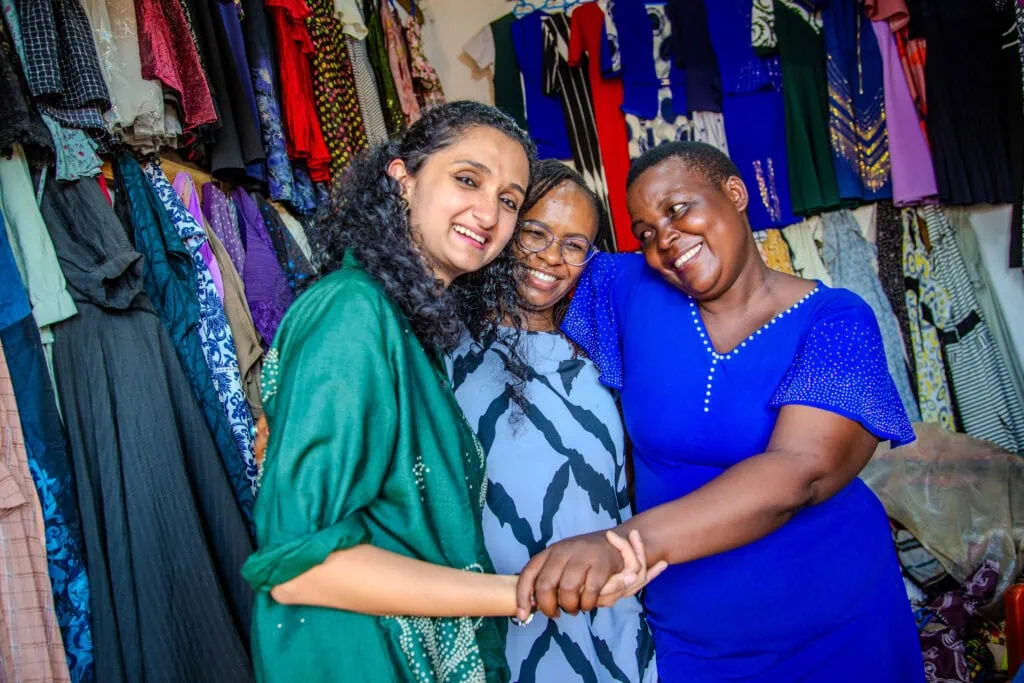
Kee Rajagopal (left) and Dr. Esther Njoroge-Muriithi (center) with fistula survivor Janet (right) at a textile shop at the entrance to Uganda Village Project.
Later we would get to Busolwe General Hospital, where 36 women had recently received life-transforming surgery. There, we met Loy, the deputy director at UVP and a fistula survivor herself. At the ward we were greeted by many happy faces but two were of particular interest. One woman, Mary, developed fistula while delivering her first child. Tragically, she lost her baby. My heart broke as she painfully shared her story of leaking urine for 33 years and how she was considered as less than human.
The second woman, Betty, greeted us with song and dance. She is a fistula ambassador, treated 12 years ago. She has committed her life to finding other women with fistula and connecting them with treatment through UVP. Janet steals the show as she dances, howls, hugs and laughs endlessly. As I lay my head to rest, all I can be is grateful for a beautiful, fulfilling day.
Tuesday, April 29
A Reflection by Kee Rajagopal
Visiting TERREWODE
We began our journey from Mbale to Soroti early this morning, and the long drive gave Esther and me a meaningful window to reflect on our long-term program goals. It was a grounding conversation that reminded us of the purpose behind our day-to-day work.
Arriving at TERREWODE was nothing short of inspiring. The facility was serene and beautifully landscaped—a dedicated space for women recovering from fistula and childbirth injuries. It is a sanctuary of healing, with 60 beds and a calm dignity to every corner.

The fistula ward at TERREWODE was a sanctuary for healing and hope.
Dr. Mary, the medical director and a fistula surgeon, had a naturally charismatic presence and brought the hospital’s mission to life as we toured the facility. We observed Dr. Henry performing surgery through the glass window of the operating theatre—a humbling moment to witness the precision and care in action.
The heart of our visit was meeting the patients. We met Joyce, just 16 years old, who is recovering from a brutal assault that left her with a fourth-degree tear. She told us quietly that she dreams of going back to school once her counseling is complete. Her strength was both heartbreaking and hopeful.
We also met a mother, Janet Nabukwasi, cradling her 3-month-old baby. During childbirth, she suffered a perineal tear and was operated on by a midwife who lacked the skills to properly manage such a complex injury. Her postpartum journey has been extremely difficult—especially during what should be a tender and supported phase in a woman’s life. Janet is now waiting for a proper surgical repair at TERREWODE, holding onto hope for healing and recovery. Later, we joined a group of women in reintegration. They danced—truly danced—with joy for being dry and healed. Their laughter and songs filled the air with a sense of triumph and resilience that was contagious.
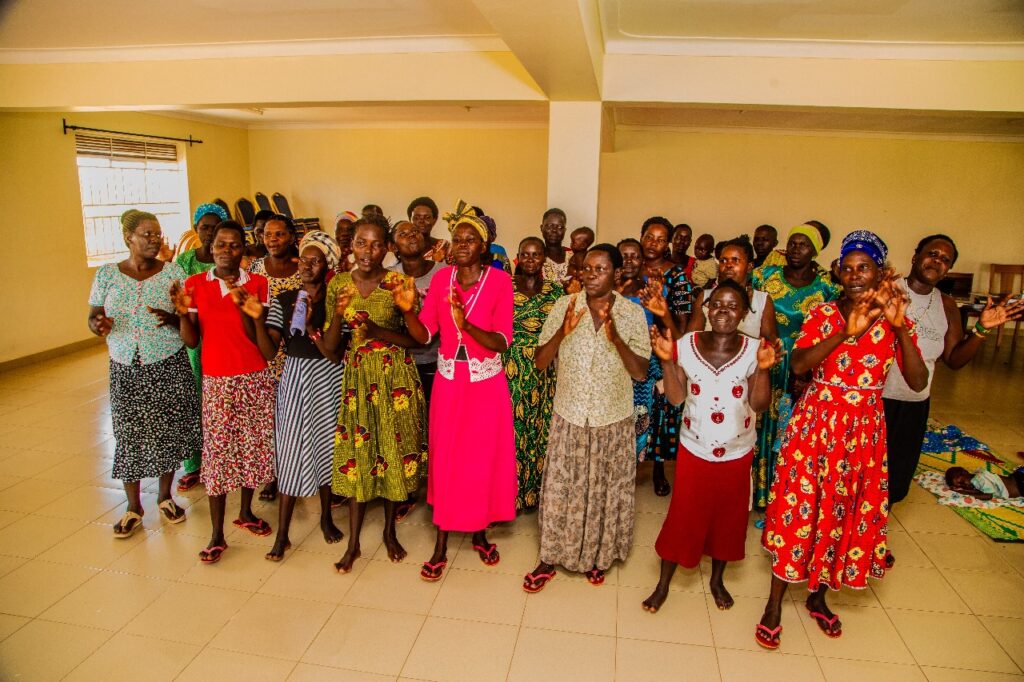
The jubilant singing of women who have been healed filled the air in the reintegration space.
We also had the privilege of meeting a senior surgeon, Dr. Fred Kirya, who has served since 1999. He reflected candidly on the state of fistula care, acknowledging that while prevalence has declined over time, the battle is far from over. “I am not sure if we are winning or losing the war,” he said, pointing to an alarming rise in new cases—especially iatrogenic fistula—a type of fistula that is caused by medical error. Sadly, as healthcare systems develop and as more providers in remote areas attempt to perform gynecological services, medical errors of this kind occur more frequently.
We spent the night in a “Mama Home,” a shared space that reflects the warmth and communal spirit that surrounds this work.
Wednesday, April 30 and Thursday, May 1
A Reflection by Dr. Esther Njoroge-Muriithi
The journey back to Kampala on April 30 took us eight hours. It was exhausting but the promise of visiting Kitovu Hospital kept spirits up. The conversations in the car were lively, interspersed with moments of sleepy gazes into the rolling countryside.
The highlight of the day was visiting the source of the Nile River, the longest river in the world!
The journey to Kitovu took us 3.5 hours, crossing the equator and pausing for camera moments. The huge fish sold by the roadside were a shocking peak into the economic activity of the area.
Visiting Kitovu Hospital
Kitovu Hospital is set in the lush greens of Masaka District. Beautiful countryside, quiet with only disruptions by the yellow birds on the trees, and of course the usual Uganda bodaboda (motorcycle used for public transport).
Here we were met by Father Emmanuel, the hospital Executive Director, and Sister Dr. Nabukalu the fistula program director. Later we would be joined by Sister Dr. Florence, the fistula surgeon.
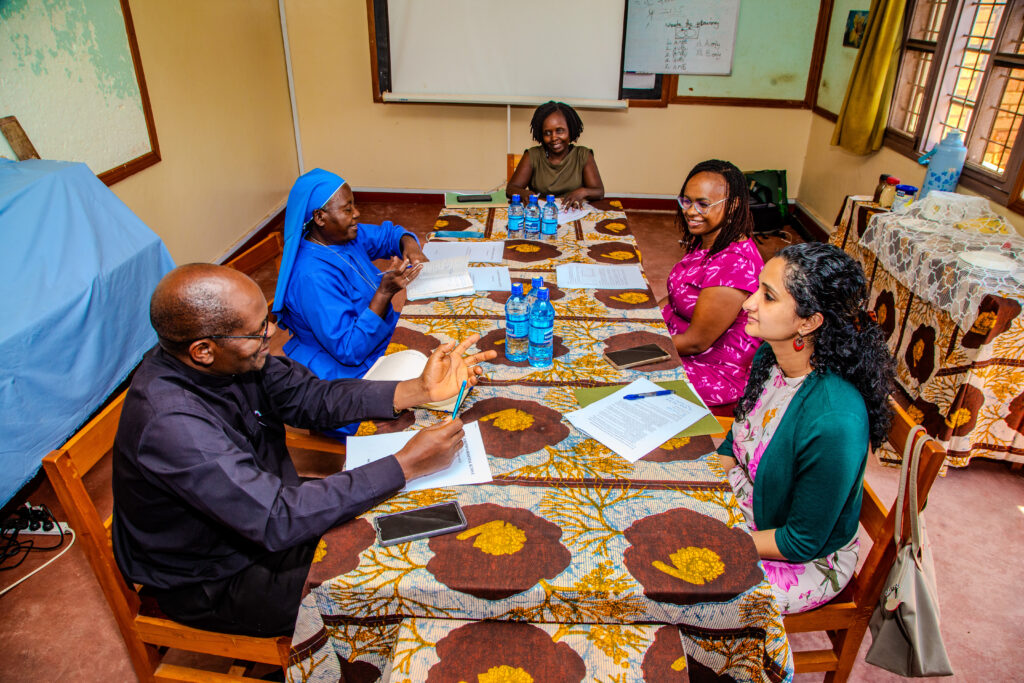
Meeting with Father Emmanuel, Sister Dr. Nabukalu, and Dr Stellah Nakiwala.
The environment is clean and well maintained with frugality. It is a large hospital serving a population of almost 3 million.
The fistula ward had few patients when we arrived, but by the end of the day it was relatively full for it was admission day for a surgical outreach effort that was commencing May 5. The ward has a capacity of 35 and was equipped by Fistula Foundation.
Sister Dr. Nabukalu led us to the hostel where almost 10 women were waiting for our arrival. They were women who had received treatment in the last year, and were now continent and dry.
They were happy women, each with their own story of how fistula had impacted their lives.
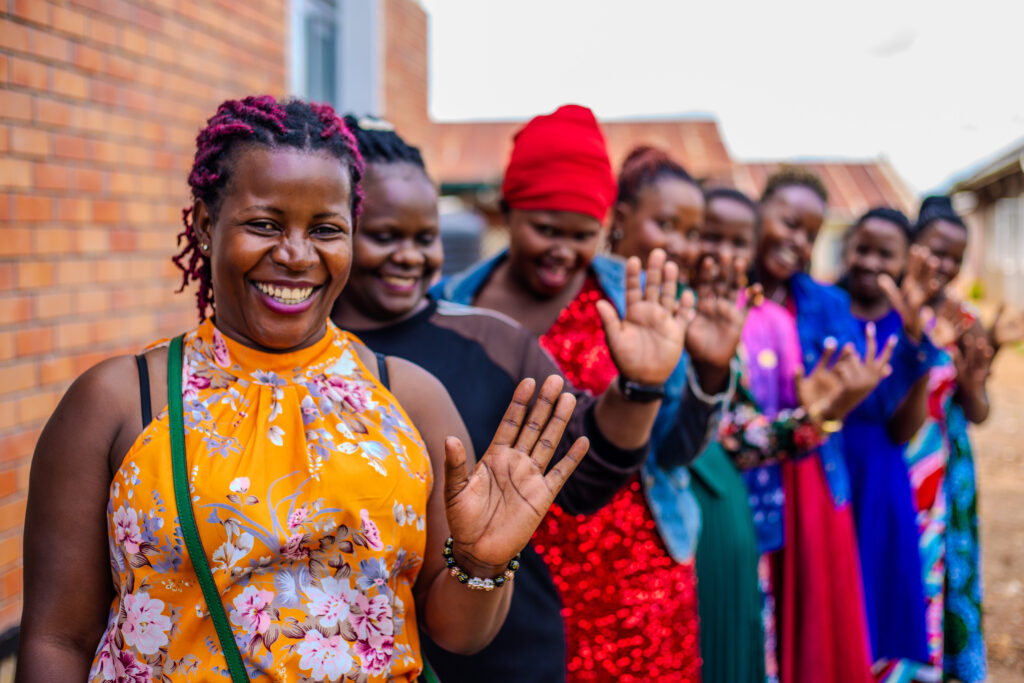
Meeting Scovia
While we were at Kitovu, we met a remarkable fistula survivor—Scovia.
Scovia wore a red dress and make up, complete with a wide smile. She narrated how for six years she lived with fistula. She was a fishmonger prior to fistula happening to her but when fistula came along, her fellow fishmongers revolted against her. They called a meeting where it was decided that she could not sell fish in that market any more. She was banished. For six years she suffered rejection even by friends because of her smell.
It has been a year since treatment and she has now started a new business of tailoring clothes that she hopes to expand. She was simply grateful for her life being restored.
Later in the day, I retired to the humble hospital guest house for the night and traded stories with Kee and Muthoni, the photographer we were traveling with. As fellow women and mothers who have undergone labor, we all felt kindred spirits to the women we were meeting. Their story could easily have been ours, and it is our journey to ensure every woman who needs fistula treatment receives the care they need. Meeting the women drives the message home, deeply.
Friday, May 2
A Reflection By Kee Rajagopal
CoRSU Hospital
It was our final day in Uganda. We left the humble guest house at Kitovu Hospital at 6:00 AM, hoping to reach CoRSU Hospital in Kisubi within three hours. But Kampala traffic had other plans, and it took nearly five hours. We arrived exhausted, but the moment we met Dr. Judith Stenkamp, our energy returned.
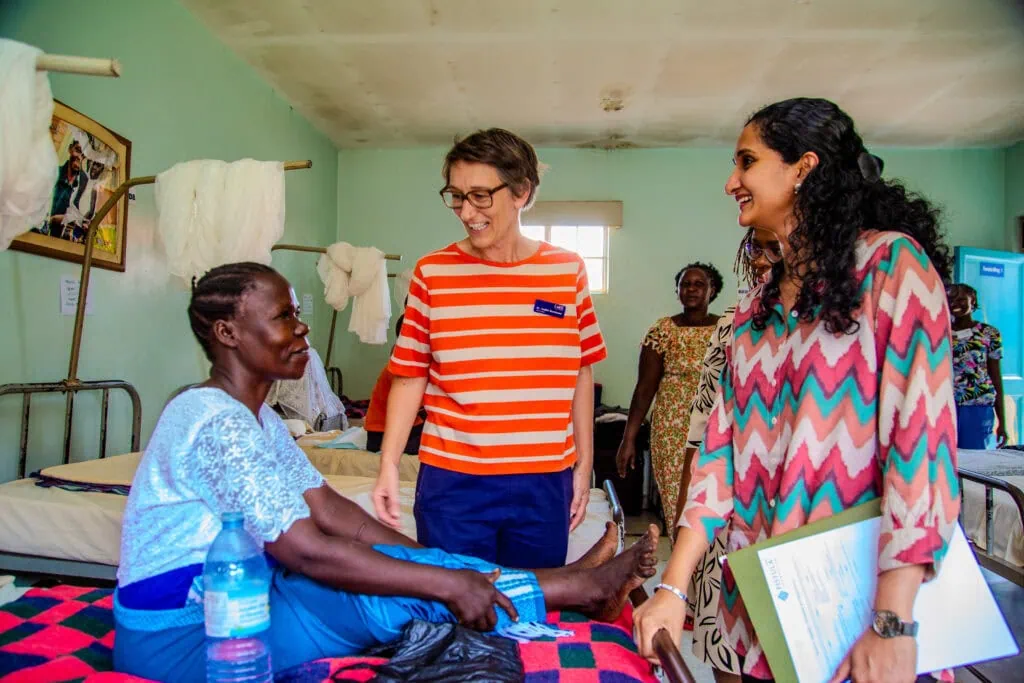
Dr. Judith Stenkamp (center) and Kee Rajagopal (right) talking to fistula patient, Linda.
A German surgeon who has made Uganda her home for the past 10 years, Dr. Judith has devoted herself entirely to fistula care. What makes her truly remarkable is how hands-on she is with every aspect of the work. At the start of each year, she sets out with her social worker and driver to screen women across multiple districts—personally. In 2025 alone, she screened over 1,000 women and identified 400 suffering from obstetric fistula or perineal tears. She meticulously tracks each case and works with local mobilizers throughout the year to ensure these women make it to CoRSU for surgery.
She proudly showed us her handwritten registers from past years—each name, each story documented with care. Later, she took us on a tour of the operating room and the larger hospital, which primarily serves children. The space was bright, filled with drawings, and in one dedicated room, she performs fistula surgeries.
As we visited the patient hostel, our spirits were lifted. Dr. Judith greeted each woman by name and had even picked up words in Luganda and other local dialects. One joyful moment was when a patient jumped out of bed, beaming, to take a picture with me. We also met Linda, a woman who had suffered since 1972. Labeled “dirty” by her community and disowned by her family, she once attempted suicide. Now healed, Linda has hope again—and a future to look forward to.
It was a moving end to our Uganda trip, one filled with inspiration, humility, and a deep sense of fulfillment.
Updated June 18, 2025
